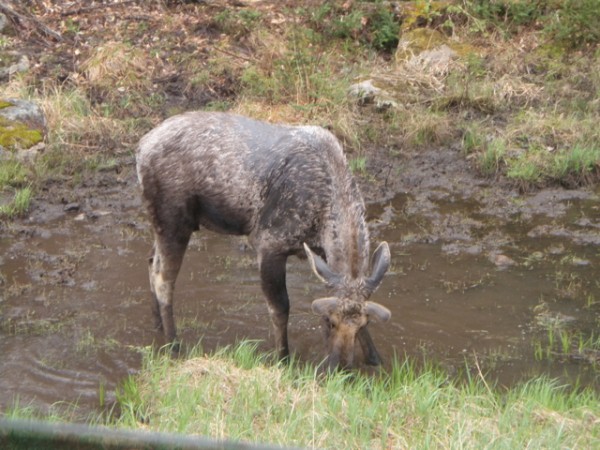TORONTO, July 24, 2014 – Some sticky research out of York University shows a surprisingly effective way to fight against a certain species of toxic grass fungus: moose saliva (yes… moose saliva).
Published in this month’s Biology Letters, “Ungulate saliva inhibits a grass–endophyte mutualism” shows that moose and reindeer saliva, when applied to red fescue grass (which hosts a fungus called epichloë festucae that produces the toxin ergovaline) results in slower fungus growth and less toxicity.
“Plants have evolved defense mechanisms to protect themselves, such as thorns, bitter-tasting berries, and in the case of certain types of grass, by harbouring toxic fungus deep within them that can be dangerous or even fatal for grazing animals,” says York U Biology Professor Dawn Bazely, who worked with University of Cambridge researcher Andrew Tanentzap and York U researcher Mark Vicari on the project. “We wanted to find out how moose were able to eat such large quantities of this grass without negative effects.”
Inspired by an earlier study that showed that moose grazing and saliva distribution can have a positive effect on plant growth, the research team set out to test an interesting hypothesis – whether moose saliva may, in fact, “detoxify” the grass before it is eaten.
Working in partnership with the Toronto Zoo, the team collected saliva samples from moose and reindeer, which they then smeared onto clipped samples of red fescue grass carrying the toxic fungus, simulating the effect of grazing. They found that the application of saliva produced rapid results, inhibiting fungus growth within 12-36 hours.
“We found that the saliva worked very quickly in slowing the growth of the fungus, and the fungus colonies,” says Bazely. “In addition, by applying multiple applications of saliva to the grass over the course of two months, we found we could lower the concentration of ergovaline between 41 and 70 per cent.”
Bazely says that because moose tend to graze within a defined home range, it’s possible that certain groups of plants are receiving repeated exposure to the moose saliva, which over time has resulted in fewer toxins within their preferred area.
“We know that animals can remember if certain plants have made them feel ill, and they may avoid these plants in future,” says Bazely. “This study is the first evidence, to our knowledge, of herbivore saliva being shown to ‘fight back’ and slow down the growth of the fungus.”
York University is helping to shape the global thinkers and thinking that will define tomorrow. York’s unwavering commitment to excellence reflects a rich diversity of perspectives and a strong sense of social responsibility that sets us apart. A York U degree empowers graduates to thrive in the world and achieve their life goals through a rigorous academic foundation balanced by real-world experiential education. As a globally recognized research centre, York is fully engaged in the critical discussions that lead to innovative solutions to the most pressing local and global social challenges. York’s 11 faculties and 28 research centres are thinking bigger, broader and more globally, partnering with 288 leading universities worldwide. York's community is strong − 55,000 students, 7,000 faculty and staff, and more than 250,000 alumni.
-30-
Media Contact: Robin Heron, Media Relations, York University, 416 736 2100 x22097/ rheron@yorku.ca


